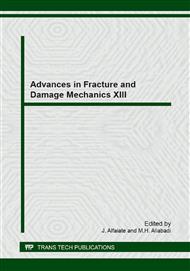p.221
p.225
p.229
p.233
p.237
p.241
p.245
p.249
p.253
Validity of the Finite Fracture Mechanics Based Asymptotic Analysis for Predictions of Crack Deflection in Thin Layers of Ceramic Laminates
Abstract:
The work studies and compares different approaches suitable for predictions of the crack deflection (bifurcation) in ceramic laminates containing thin layers under high residual stresses and discuss a suitability and limits of using of the asymptotic analysis for such problems. The thickness of the thin compressive layers where the crack deflection occurs is only one order higher than the crack extension lengths considered within the solution. A purely FEM based calculation of the energy and stress conditions, necessary for the crack propagation, serves as the reference solution to the problem. The asymptotic analysis is used after for calculations of the same quantities (especially of energy release rate – ERR). This concept enables semi-analytical calculations of ERR or changes in potential energy induced by the crack extensions of different lengths and directions. Such approach can save a large amount of simulations and time compared with the pure FEM based calculations. It was found that the asymptotic analysis provides a good agreement for investigations of the crack increments enough far from the adjacent interfaces but for longer extensions (of length above 1/5-1/10 of the distance from the interface) starts more significantly to deviate from the correct solution. Involvement of the higher order terms in the asymptotic solution or other improvement of the model is thus advisable.
Info:
Periodical:
Pages:
237-240
Citation:
Online since:
September 2014
Authors:
Keywords:
Price:
Сopyright:
© 2015 Trans Tech Publications Ltd. All Rights Reserved
Share:
Citation:


